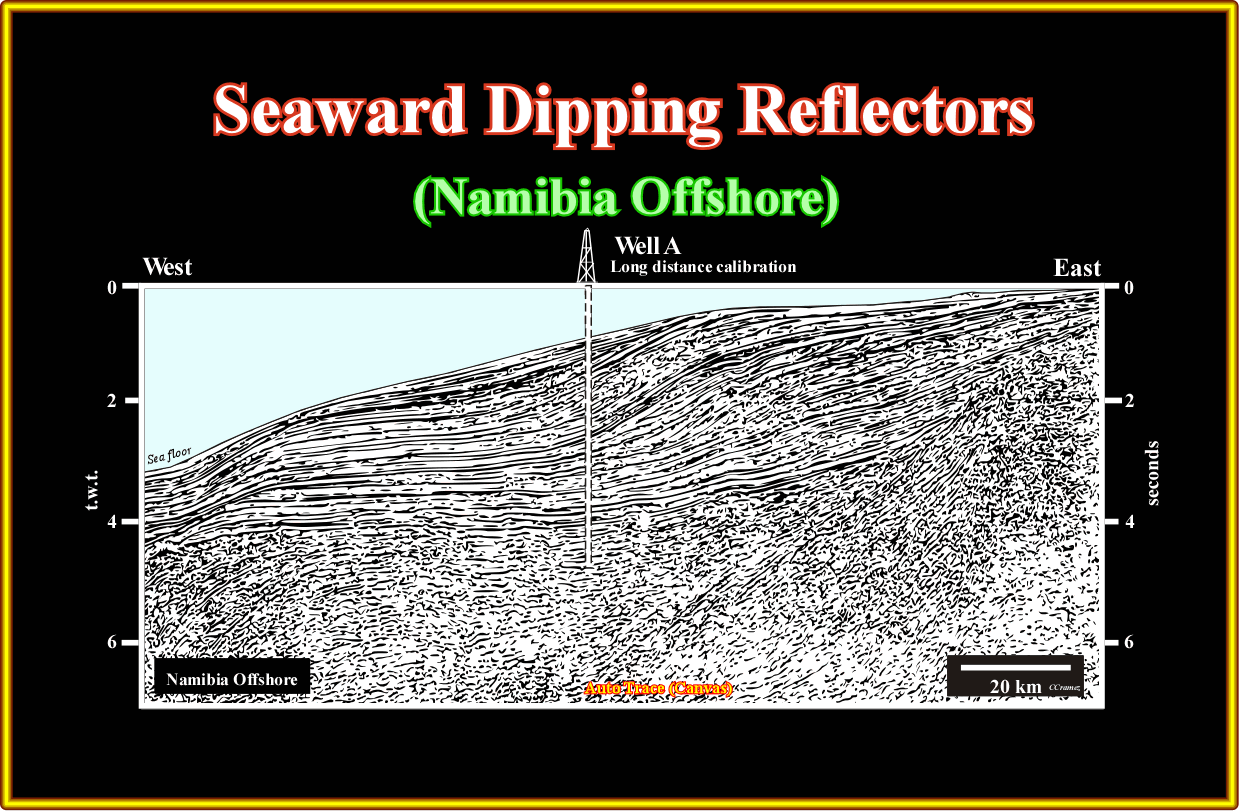

Caveat:
These notes should not be taken as an attempt to write a textbook on the Atlantic-Type Divergent Margins. They are just an eclectic assemblage of geological models, cross-sections and tentative geological interpretations of seismic lines used not only to test the post-breakup salt hypothesis, proposed, in 2000, by few Total's geoscientists, to explain the opening of South Atlantic, but to show that such hypothesis seems to be valid in almost all Atlantic-type divergent margins associated with the breakup of the Gondwana Supercontinent (southern continent of the Pangea). We are the responsible of all the tentative geological interpretations of the seismic lines here illustrated. In any case, they suggest the scientific position of the oil companies that allowed us to use the original line. If you want contact me, please, send a E-mail to (carloscramez@gmail.com).

Plate 001- Notice that this picture is not the original composite seismic line. In fact, due to confidential reasons, in these notes any original seismic line will be shown, except those already published in geological scientific papers. Actually, this plate illustrated a visual representation of the original seismic line made by auto tracing (Canvas) or by pencil lines underlining the significant seismic reflectors and, particularly, the chronostratigraphic reflectors. The proposed tentative geological interpretations, however, were done on the real original seismic line and, then, overlain on the simulated lines, as shown in the next plate.
Plate 001A- This tentative geological interpretation of a regional composite seismic line of the Congo basin offshore (North Angola offshore) illustrates a typical Atlantic-type divergent margin, in which, from bottom to top, different basin-types can be recognized : (i) Paleozoic fold belt or basement ; (ii) Rift-type basins predating the breakup of the Pangea lithosphere and (iii) a Meso-Cenozoic divergent Atlantic-type margin. The infrastructure of the rift-type basins is always the continental crust (we don't know any rift-type basin developed within volcanic material, particularly in subaerial lava flows). On the contrary, the infrastructure of the divergent margin is either the continental crust (proximal offshore) or volcanic crust (subaerial in the proximal areas and oceanic, that is to say, pillow lava), in the distal areas. The continental oceanic boundary (COB), i.e., the limit between the volcanic and continental crust is quite subtle due to the presence of an intermediated subaerial volcanic crust (SDRs), except when fracture zones put in abruptly juxtaposition the sialic continental crust with the volcanic (subaerial or oceanic), as it is the case in the western part of this tentative interpretation, which cuts two major fracture zones. The rift-type basins have a half-graben geometry and a quite sharp landward vergence with the in filling sediments showing a, more or less, parallel internal configuration dipping continentward. A thick infrasalt margin depocenter postdating the breakup of the Gondwana supercontinent (the post-breakup unconformity in underlined by a blue undulated line), often mistakenly dubbed "sag basin" is easily recognized in the central area. The petroleum exploration of this offshore has been concentrated in the Tertiary sediments (in beige color), where seismic amplitude anomalies exploration bas been quite successful. Below the inversion level, where amplitude anomalies do not exist anymore, there are just one or two exploration wells, in spite of the fact of the presence of quite evident petroleum systems, probably similar to those found in conventional offshore (block 3, 2, 1, etc.). A generating petroleum subsystem seems quite evident on the margin infrasalt depocenter (in yellow on this tentative interpretation), which compensates, in this area, the absence of prospective rift-type basins (too small to allow the development of organic rich lacustrine shales, as it is the case in eastern part of this composite line). By the same token, one can say that several migration-entrapment petroleum subsystems area likely on the Cretaceous carbonates and infra-salt sediments.
Contents:
I - Definition of Atlantic-type Divergent Margin
III - Conventional Models
IV - Seismic Examples (testing)
A5- Brazil (Cabo Frio Offshore)
A7- Brazil (Espirito Santo Offshore)
A9- Brazil (Sergipe Alagoas Offshore)
A10- Brazil (Pernambuco Parnaíba Offshore)
A11- Brazil (Potiguar Offshore)
A13- Brazil (Piauí Ceará Offshore)
A14- Brazil (Barreirinhas Offshore)
A15- Brazil (Pará Maranhão Offshore)
A19- USA Offshore (Gulf of Mexico)
A20- USA Offshore (Virginia Offshore)
A21- USA Offshore (Baltimore Canyon)
A22- Canada Offshore (Nova Scotia Offshore)
A23- Canada Offshore (Labrador Sea)
A24- Canada Offshore (Baffin Bay Offshore)
A25- Denmark Offshore (West Greenland Offshore)
A26- Denmark Offshore (East Greenland Offshore)
A27- Norway Offshore (Lofotens Offshore)
A28- Norway Offshore (South Lofotens Offshore)
A29- Norway Offshore (Voring Plateau)
A30- UK Offshore (West Shetlands)
A31- UK Offshore (Rockwall Trough)
A32- UK Offshore (Porcupine Basin)
A33- France Offshore (Armorican Offshore)
A34- Spain-France Offshore (Biscay Bay)
A35- Spain Offshore (Galicia Offshore)
A36- Portugal Offshore (Lusitania & Alentejo Basins)
A45- Equatorial Guinea Offshore
A48- Congo-Angola Offshore (Congo Basin)
A49- Angola Offshore (Kwanza Basin)
A57- North Australia Offshore (Kaitanimbar)
A61- Antarctic Offshore
V - Bibliography

Send E-mail to carloscramez@gmail.com with questions or comments about these notes (Altlantic-type Divergent Continental Margins).
Copyright © 2012 CCramez
Last modification:July, 2014